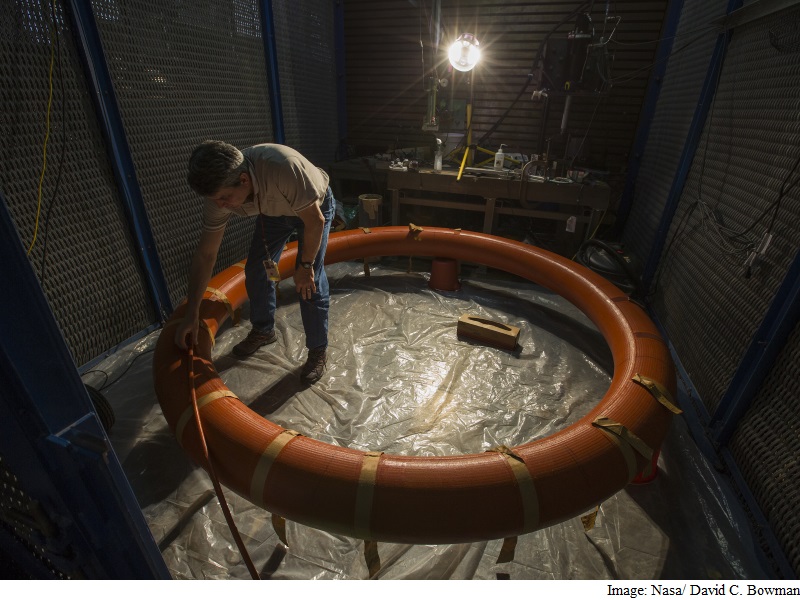- Home
- Science
- Science News
- Nasa Testing Inflatable Heat Shield Technology for Manned Mars Mission
Nasa Testing Inflatable Heat Shield Technology for Manned Mars Mission

Engineers recently put the technology to the test by packing a nine-foot diameter donut-shaped test article - also known as a torus - to simulate what would happen before a space mission.
Called the Hypersonic Inflatable Aerodynamic Decelerator (HIAD), it works like a parachute, using the drag of a planet's atmosphere to slow the space vehicle as it descends toward the surface.
Slowing the spacecraft protects it from the intense heat of atmospheric entry and allows it to land more softly.
The technology will enable the delivery of heavy cargo, science instruments and people to other worlds.
It could also be used to retrieve cargo from the International Space Station (ISS) and return it to Earth.
"During testing, we used a vacuum pump to compress the test article into a small space," said Keith Johnson, a lead engineer for the project in a statement.
"We packed and unpacked it and did thorough inspections to check for leaks and damage to the Zylon and Teflon materials. We repeated this three times," he added.
According to test engineer Sean Hancock, HIAD was packed the same way each time to see how the material would handle folding, packing, and compressing.
Doing so helps engineers understand how it would perform after exposure to handling, storage and deployment during a space flight mission.
"The test included all the components for the latest inflatable torus design, so it was a good final check to prove that the materials can tolerate packing," Johnson added.
After the successful testing, Nasa engineers can move forward in the development of creating a larger HIAD that can withstand the stress of being tightly packed in a rocket and the high temperatures experienced when it descends through the atmosphere of a planet such as Mars.
"In the end, we'll have a complete system that will be tested to show that it can meet the requirements for a space flight mission whether it's going to be returning a vehicle to Earth or future Mars missions," Johnson noted.
For the latest tech news and reviews, follow Gadgets 360 on X, Facebook, WhatsApp, Threads and Google News. For the latest videos on gadgets and tech, subscribe to our YouTube channel. If you want to know everything about top influencers, follow our in-house Who'sThat360 on Instagram and YouTube.
Related Stories
- Samsung Galaxy Unpacked 2025
- ChatGPT
- Redmi Note 14 Pro+
- iPhone 16
- Apple Vision Pro
- Oneplus 12
- OnePlus Nord CE 3 Lite 5G
- iPhone 13
- Xiaomi 14 Pro
- Oppo Find N3
- Tecno Spark Go (2023)
- Realme V30
- Best Phones Under 25000
- Samsung Galaxy S24 Series
- Cryptocurrency
- iQoo 12
- Samsung Galaxy S24 Ultra
- Giottus
- Samsung Galaxy Z Flip 5
- Apple 'Scary Fast'
- Housefull 5
- GoPro Hero 12 Black Review
- Invincible Season 2
- JioGlass
- HD Ready TV
- Laptop Under 50000
- Smartwatch Under 10000
- Latest Mobile Phones
- Compare Phones
- Moto G15 Power
- Moto G15
- Realme 14x 5G
- Poco M7 Pro 5G
- Poco C75 5G
- Vivo Y300 (China)
- HMD Arc
- Lava Blaze Duo 5G
- Asus Zenbook S 14
- MacBook Pro 16-inch (M4 Max, 2024)
- Honor Pad V9
- Tecno Megapad 11
- Redmi Watch 5
- Huawei Watch Ultimate Design
- Sony 65 Inches Ultra HD (4K) LED Smart TV (KD-65X74L)
- TCL 55 Inches Ultra HD (4K) LED Smart TV (55C61B)
- Sony PlayStation 5 Pro
- Sony PlayStation 5 Slim Digital Edition
- Blue Star 1.5 Ton 3 Star Inverter Split AC (IC318DNUHC)
- Blue Star 1.5 Ton 3 Star Inverter Split AC (IA318VKU)

















